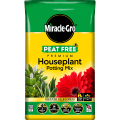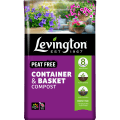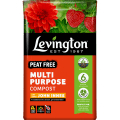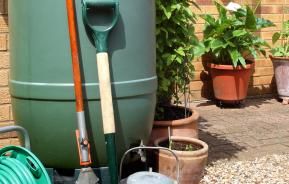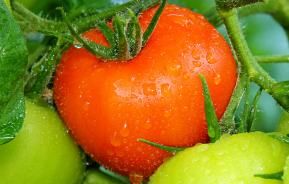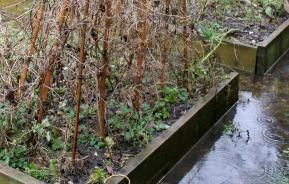It makes sense to make the best use of water in the garden – especially during times of prolonged dry periods and droughts and if you have a water meter!
In brief
There is a range of measures you can take to reduce your reliance on water in the garden, as well as techniques you can use to conserve the precious water you have.
Save water
You should collect water from downpipes on your house, garage and greenhouse by plumbing in water butts, using easy-to-install water diverter kits.
Recycle ‘grey water’ from your house. This is the water that has been used for washing-up, baths or in the washing machine. You will have to wait for it to cool and transferring it to the right part of the garden can be tricky. Ironically, the easiest method is to use a hosepipe to siphon the water to where it is needed, but this may fall foul of an existing hosepipe ban!
The water will contain soaps and detergents that are generally alkaline, so it is not suitable for acid-loving plants, such as rhododendrons and camellias. Some plants are susceptible to the salts and chemicals in greywater, so don’t use it on seedlings or young plants and in the vegetable garden.
Choose the right plants
If you are planting up a new garden or border, or even your summer containers, use drought-tolerant or drought-resisting plants. There are lots to chose from, and good indicators of drought-resistance include fleshy leaves, waxy leaves, hairy leaves, silver or grey leaves, grass-like leaves and scented foliage.
And don’t buy the biggest plants – smaller plants establish quicker and need less water and soon overtake bigger plants as they develop much greater resilience by adapting to their conditions from a young age.
Plant correctly
Even drought-resisting plants will need to be properly watered until they are well established.
Before planting, make sure you add lots of bulky organic matter, such as well-rotted manure, garden compost or planting compost to the soil and the planting hole to increase the water-holding capacity of the soil.
You can improve the soil’s water-holding ability even further by adding water-retaining gels to the soil. These are normally used in compost in pots, containers and hanging baskets, but can be used in the soil as well.
Before planting, soak the compost in the pot. Stand the pot in a bucket of water for around 20 minutes, then fill the planting hole with water and allow it to drain. Place the soaked rootball into the planting hole and plant as normal.
During very hot, sunny days, shade all new plants with fleece or netting to reduce water stress. Ideally, plant in the evening to give the plants some respite before temperatures rise again the following day.
After planting, cover the soil with a generous mulch of composted bark, bark chips, well-rotted garden compost or whatever you used as the planting material. This will help prevent water loss from the soil’s surface, as well as preventing weeds, which will steal valuable soil moisture.
Water properly
Not all plants need regular watering or any watering, even during prolonged drought. Well-established plants and especially drought-resisting plants will rarely need watering, but keep an eye on them for signs of wilting or water stress. Rhododendrons, camellias, hydrangeas and other shallow-rooted plants, on the other hand, may need regular/weekly watering to ensure good flower bud set and flowering.
Some plants will need much more regular watering to grow well (see below), but good watering techniques are essential. When watering, always water directly onto the soil, not all over the plants and their foliage. Give a thorough watering to ensure the soil is soaked right down to the root zone, just ‘splashing’ water here and there will keep the plant roots close to the surface, where they will be more prone to drying out and drought.
A thorough soaking once a week is far better than less thorough daily watering. And, since the surface will be wetted less often, there will be less water lost through evaporation. For the same reason, it’s also worth watering in the evening, rather than during the heat of the day.
Other good watering ideas
- Create a ridge of soil around individual plants to form a circular barrier that will prevent the water from running off before it has had time to soak in.
- Sink an empty plant pot rim-deep or even an upturned lemonade bottle with the bottom removed into the soil alongside thirsty plants. By filling this with water it will ensure the water gets right down to the root zone.
Plants growing in containers should also be given a thorough watering, but without overwatering, wasting water as it runs out of the drainage holes. In some situations, such as with growing-bags, it is often better to set up drip watering bags or bottles, which will help keep the compost evenly moist without drying out.
What needs watering?
- All new plants: water thoroughly, once a week throughout drought periods.
- Container plants: water routinely whenever plants need it, probably daily or even every other day; plants in hanging baskets may need watering twice a day.
- Leafy vegetable crops: water regularly during dry periods.
- Vegetable crops with fruit, pods or tubers: water is essential when pods or tubers are swelling.
- Fruit trees, bushes and canes: For most fruit plants, especially bushes and canes, water is essential when the fruit is swelling.
Mulching
A 5 to 10cm (2 to 4in) deep mulch (soil covering) placed on the soil around plants will help insulate the roots from hot, sunny conditions and maintain soil moisture levels. It will also help keep weeds down (see control weeds, below). It is important to ensure the mulch is only put down when the soil is already moist.
Control weeds
As weeds are unwanted plants and have their own soil moisture needs, it makes sense to remove them as soon as possible so they don’t steal valuable water supplies from your plants.
Hoeing regularly, mulching and using planting membranes and weedkillers are all ways of keeping weeds under control.


